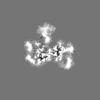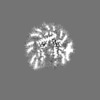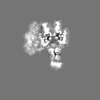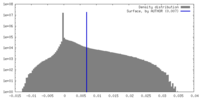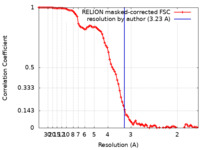[English] 日本語
 Yorodumi
Yorodumi- EMDB-39800: cryo-EM map of RNF168(1-193) in complex with Ubc5c-Ub conjugated ... -
+ Open data
Open data
- Basic information
Basic information
| Entry |  | |||||||||
|---|---|---|---|---|---|---|---|---|---|---|
| Title | cryo-EM map of RNF168(1-193) in complex with Ubc5c-Ub conjugated nucleosome at a resolution of 3.23 angstrom | |||||||||
 Map data Map data | 3.23 angstrom cryo-EM map of RNF168(1-193)-Ubc5c-NCP complex | |||||||||
 Sample Sample |
| |||||||||
 Keywords Keywords | nucleosome / RNF168 / H2AK13/15 / UbcH5c-Ub / NUCLEAR PROTEIN | |||||||||
| Biological species |  Homo sapiens (human) Homo sapiens (human) | |||||||||
| Method | single particle reconstruction / cryo EM / Resolution: 3.23 Å | |||||||||
 Authors Authors | Ai HS / Tong ZB / Deng ZH / Tian CL / Liu L / Pan M | |||||||||
| Funding support |  China, 1 items China, 1 items
| |||||||||
 Citation Citation |  Journal: Nat Chem Biol / Year: 2025 Journal: Nat Chem Biol / Year: 2025Title: Mechanism of nucleosomal H2A K13/15 monoubiquitination and adjacent dual monoubiquitination by RNF168. Authors: Huasong Ai / Zebin Tong / Zhiheng Deng / Qiang Shi / Shixian Tao / Gaoge Sun / Jiawei Liang / Maoshen Sun / Xiangwei Wu / Qingyun Zheng / Lujun Liang / Hang Yin / Jia-Bin Li / Shuai Gao / ...Authors: Huasong Ai / Zebin Tong / Zhiheng Deng / Qiang Shi / Shixian Tao / Gaoge Sun / Jiawei Liang / Maoshen Sun / Xiangwei Wu / Qingyun Zheng / Lujun Liang / Hang Yin / Jia-Bin Li / Shuai Gao / Changlin Tian / Lei Liu / Man Pan /   Abstract: The DNA damage repair regulatory protein RNF168, a monomeric RING-type E3 ligase, has a crucial role in regulating cell fate and DNA repair by specific and efficient ubiquitination of the adjacent ...The DNA damage repair regulatory protein RNF168, a monomeric RING-type E3 ligase, has a crucial role in regulating cell fate and DNA repair by specific and efficient ubiquitination of the adjacent K13 and K15 (K13/15) sites at the H2A N-terminal tail. However, understanding how RNF168 coordinates with its cognate E2 enzyme UbcH5c to site-specifically ubiquitinate H2A K13/15 has long been hampered by the lack of high-resolution structures of RNF168 and UbcH5c~Ub (ubiquitin) in complex with nucleosomes. Here we developed chemical strategies and determined the cryo-electron microscopy structures of the RNF168-UbcH5c~Ub-nucleosome complex captured in transient H2A K13/15 monoubiquitination and adjacent dual monoubiquitination reactions, providing a 'helix-anchoring' mode for monomeric E3 ligase RNF168 on nucleosome in contrast to the 'compass-binding' mode of dimeric E3 ligases. Our work not only provides structural snapshots of H2A K13/15 site-specific monoubiquitination and adjacent dual monoubiquitination but also offers a near-atomic-resolution structural framework for understanding pathogenic amino acid substitutions and physiological modifications of RNF168. | |||||||||
| History |
|
- Structure visualization
Structure visualization
| Supplemental images |
|---|
- Downloads & links
Downloads & links
-EMDB archive
| Map data |  emd_39800.map.gz emd_39800.map.gz | 6.2 MB |  EMDB map data format EMDB map data format | |
|---|---|---|---|---|
| Header (meta data) |  emd-39800-v30.xml emd-39800-v30.xml emd-39800.xml emd-39800.xml | 16.8 KB 16.8 KB | Display Display |  EMDB header EMDB header |
| FSC (resolution estimation) |  emd_39800_fsc.xml emd_39800_fsc.xml | 9.1 KB | Display |  FSC data file FSC data file |
| Images |  emd_39800.png emd_39800.png | 123.2 KB | ||
| Filedesc metadata |  emd-39800.cif.gz emd-39800.cif.gz | 4 KB | ||
| Others |  emd_39800_additional_1.map.gz emd_39800_additional_1.map.gz emd_39800_additional_2.map.gz emd_39800_additional_2.map.gz emd_39800_half_map_1.map.gz emd_39800_half_map_1.map.gz emd_39800_half_map_2.map.gz emd_39800_half_map_2.map.gz | 1.6 MB 5.8 MB 49.6 MB 49.7 MB | ||
| Archive directory |  http://ftp.pdbj.org/pub/emdb/structures/EMD-39800 http://ftp.pdbj.org/pub/emdb/structures/EMD-39800 ftp://ftp.pdbj.org/pub/emdb/structures/EMD-39800 ftp://ftp.pdbj.org/pub/emdb/structures/EMD-39800 | HTTPS FTP |
-Validation report
| Summary document |  emd_39800_validation.pdf.gz emd_39800_validation.pdf.gz | 761.9 KB | Display |  EMDB validaton report EMDB validaton report |
|---|---|---|---|---|
| Full document |  emd_39800_full_validation.pdf.gz emd_39800_full_validation.pdf.gz | 761.5 KB | Display | |
| Data in XML |  emd_39800_validation.xml.gz emd_39800_validation.xml.gz | 16 KB | Display | |
| Data in CIF |  emd_39800_validation.cif.gz emd_39800_validation.cif.gz | 21.2 KB | Display | |
| Arichive directory |  https://ftp.pdbj.org/pub/emdb/validation_reports/EMD-39800 https://ftp.pdbj.org/pub/emdb/validation_reports/EMD-39800 ftp://ftp.pdbj.org/pub/emdb/validation_reports/EMD-39800 ftp://ftp.pdbj.org/pub/emdb/validation_reports/EMD-39800 | HTTPS FTP |
-Related structure data
- Links
Links
| EMDB pages |  EMDB (EBI/PDBe) / EMDB (EBI/PDBe) /  EMDataResource EMDataResource |
|---|
- Map
Map
| File |  Download / File: emd_39800.map.gz / Format: CCP4 / Size: 64 MB / Type: IMAGE STORED AS FLOATING POINT NUMBER (4 BYTES) Download / File: emd_39800.map.gz / Format: CCP4 / Size: 64 MB / Type: IMAGE STORED AS FLOATING POINT NUMBER (4 BYTES) | ||||||||||||||||||||||||||||||||||||
|---|---|---|---|---|---|---|---|---|---|---|---|---|---|---|---|---|---|---|---|---|---|---|---|---|---|---|---|---|---|---|---|---|---|---|---|---|---|
| Annotation | 3.23 angstrom cryo-EM map of RNF168(1-193)-Ubc5c-NCP complex | ||||||||||||||||||||||||||||||||||||
| Projections & slices | Image control
Images are generated by Spider. | ||||||||||||||||||||||||||||||||||||
| Voxel size | X=Y=Z: 0.8697 Å | ||||||||||||||||||||||||||||||||||||
| Density |
| ||||||||||||||||||||||||||||||||||||
| Symmetry | Space group: 1 | ||||||||||||||||||||||||||||||||||||
| Details | EMDB XML:
|
-Supplemental data
-Additional map: 4.54 angstrom cryo-EM map of RNF168(1-193)-Ubc5c complex
| File | emd_39800_additional_1.map | ||||||||||||
|---|---|---|---|---|---|---|---|---|---|---|---|---|---|
| Annotation | 4.54 angstrom cryo-EM map of RNF168(1-193)-Ubc5c complex | ||||||||||||
| Projections & Slices |
| ||||||||||||
| Density Histograms |
-Additional map: 3.59 angstrom cryo-EM map of RNF168(1-193)-Ubc5c-Ub-NCP complex
| File | emd_39800_additional_2.map | ||||||||||||
|---|---|---|---|---|---|---|---|---|---|---|---|---|---|
| Annotation | 3.59 angstrom cryo-EM map of RNF168(1-193)-Ubc5c-Ub-NCP complex | ||||||||||||
| Projections & Slices |
| ||||||||||||
| Density Histograms |
-Half map: #1
| File | emd_39800_half_map_1.map | ||||||||||||
|---|---|---|---|---|---|---|---|---|---|---|---|---|---|
| Projections & Slices |
| ||||||||||||
| Density Histograms |
-Half map: #2
| File | emd_39800_half_map_2.map | ||||||||||||
|---|---|---|---|---|---|---|---|---|---|---|---|---|---|
| Projections & Slices |
| ||||||||||||
| Density Histograms |
- Sample components
Sample components
-Entire : RNF168(1-193) in complex with Ubc5c-Ub conjugated nucleosomes
| Entire | Name: RNF168(1-193) in complex with Ubc5c-Ub conjugated nucleosomes |
|---|---|
| Components |
|
-Supramolecule #1: RNF168(1-193) in complex with Ubc5c-Ub conjugated nucleosomes
| Supramolecule | Name: RNF168(1-193) in complex with Ubc5c-Ub conjugated nucleosomes type: complex / ID: 1 / Parent: 0 |
|---|---|
| Source (natural) | Organism:  Homo sapiens (human) Homo sapiens (human) |
-Experimental details
-Structure determination
| Method | cryo EM |
|---|---|
 Processing Processing | single particle reconstruction |
| Aggregation state | particle |
- Sample preparation
Sample preparation
| Buffer | pH: 7.5 |
|---|---|
| Vitrification | Cryogen name: ETHANE |
- Electron microscopy
Electron microscopy
| Microscope | FEI TITAN KRIOS |
|---|---|
| Image recording | Film or detector model: GATAN K3 (6k x 4k) / Average electron dose: 2.066 e/Å2 |
| Electron beam | Acceleration voltage: 300 kV / Electron source:  FIELD EMISSION GUN FIELD EMISSION GUN |
| Electron optics | Illumination mode: FLOOD BEAM / Imaging mode: BRIGHT FIELD / Nominal defocus max: 2.0 µm / Nominal defocus min: 1.0 µm |
| Experimental equipment |  Model: Titan Krios / Image courtesy: FEI Company |
 Movie
Movie Controller
Controller


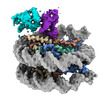

 Z (Sec.)
Z (Sec.) Y (Row.)
Y (Row.) X (Col.)
X (Col.)











